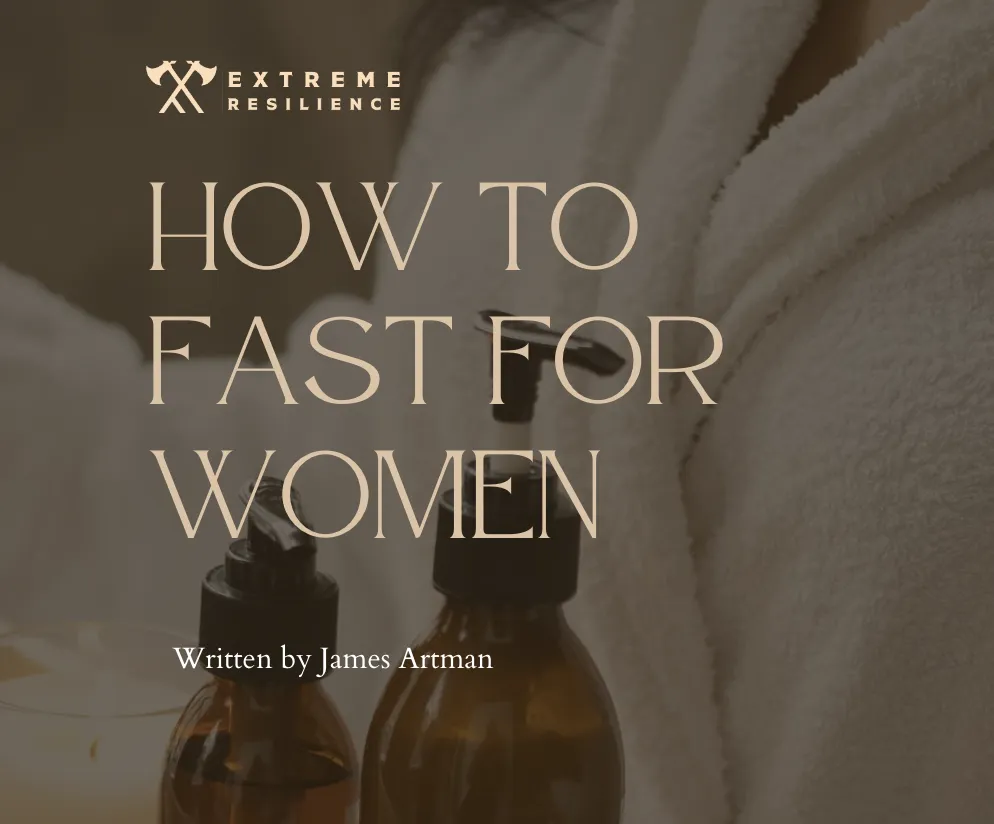Choosing Resilience Blog:

How to Fast for Women
“Eating three meals a day and never fasting causes our bodies to accumulate metabolic junk.”
Introduction:
Since 2016 when Yoshino Ohsumi received the nobel prize for discovering the mechanisms behind autophagy, intermittent fasting has blown up as the newest diet craze. Although tons of research has since proven it to be an effective strategy for weight loss, that is arguably the least significant benefit. The benefits of fasting have been well know for thousands of years albeit not completely understood until recently. Pretty much every religion mentions fasting in their religious text or still uses it today as part of their religious rituals, practices.
For those who may not yet be familiar with IF, there are several variations on the theme. Before I get into the various methods for “time restricted eating” I would like to point out that when I have encouraged people to incorporate fasting into their wellness toolkit, I am often met with much resistance. The idea of not eating for 16-18 hours immediately elicits fear and disbelief as something they would actually be capable of following through with. We have all grown up in a culture where three meals a day is the norm, or even heard that frequent meals “keeps your metabolism high” a prerequisite for maintaining an optimal physique. Many civilizations throughout human history have eaten differently. Romans, typically only ate lunch and believed eating more than one meal a day was a form of gluttony, and Native Americans only ate when they were hungry. If you would like to learn more about where each meal, breakfast, lunch and dinner came from in human history, there is a great article that goes into more detail here, from BBC.
This is an extremely important process that is never being utilized by all who continue to consume three meals a day considering a person with a healthy BMI (body mass index) takes about 12 hours for insulin levels to drop to basal levels, triggering this process to begin. Like I mentioned in the beginning of this article, the weight loss is really just an added bonus, and the reason this process is so important is because of this. Without ever going into a state of repair and regeneration, your body will continue to try to operate on old cells, organelles, and proteins that are oxidized, damaged, not operating efficiently and causing damage themselves. It’s like trying to keep alive that 91' honda civic you never changed the oil in high school 20, 30, 40 years later without ever putting on new parts.

Another analogy I have heard before I feel is useful is to think about the trash that accumulates in the trash cans and dumpsters in NYC. Everyday, citizens, restaurants and pedestrians pile thousands of pounds of trash up on the sides of the roads, knowing that the trash truck will come in the morning to collect it. Well, never fasting is like the trash trucks never showing up. Imagine how terrible of a situation it would be if that was the case. This is what is happening in your body, the accumulation of metabolic junk.
As someone who has been fasting off and on for about five years, I can personally attest to the fact that getting started is the hardest part. It can be especially difficult if during the period of time you weren’t fasting, you completely went off the rails, as my wife likes to call it, consuming processed carbohydrates, snacking and drinking your calories. Almost everyone on the planet struggles to stick to a diet, fasting is no different. In order to ameliorate this lack of compliance he was experiencing while working with cancer patients, Dr. Valter Longo developed what he calls the “Fasting Mimicking Diet” which is basically consuming a healthy whole foods, mediterranean diet but restricting the caloric intake to about 800-1000 calories a day, in effect mimicking the effects of time restricted eating. This is a good place to start if an 18 hour hiatus from food sounds down right miserable or impossible for you. After about two weeks of this, your body will be much more responsive to the idea of a feeding window, which in my opinion is optimal. Without digging too deep into the science of why all of this works, you must know that autophagy, or being in a fasted state is very much correlated to blood glucose and insulin levels. Once your insulin levels drop to fasting levels mTOR (mechanistic target of rapamycin) down regulates an puts you into a state of repair and regeneration. Most if not all multi-cellular organisms have the mTOR signaling pathway in order to utilize on board resources when exogenous ones have been depleted, like with fasting.
At this point I would like to point out that there is never a one size fits all approach when it comes to healing our bodies. The same holds true for fasting. As I discussed earlier, it can take up to 12 hours for a generally lean individuals insulin levels to drop to a low enough level to kick this process off. What about someone who is 20-30 lbs overweight with a BMI over 25 or more? This is why I prefer a 4-6 hour feeding window providing a full 16-18 hours between meals. Later on I will share some effective strategies that will make this easier for you, which finally leads me to why I wrote this article for women.
In response over concern that IF could have negative impacts on women’s reproductive hormones a team of researchers led by Krista Varaday, professor of nutrition at University of Illinois Chicago studied a group of pre and post menopausal obese women for 8 weeks to determine the impacts of a 4 hour time restricted feeding window with no calorie restriction. During the study they measured estrogen, estradiol, estrone and progesterone and observed no changes at the end of the 8 week period compared to controls. What they did find though was that the precursor hormone DHEA (dyhydroepiandosterone) had dropped a wopping 14% during the study, but returned to normal levels at the end of the 8 weeks. It is also important to mention that there were no observed changes in testosterone or androstenedione. Further the dieters saw a significant drop in insulin resistance and biomarkers of oxidative stress.
So why is this significant? DHEA, mentioned earlier, ultimately derived from consuming healthy fats is the sole substrate, processed in our adrenal glands to be later converted into sex hormones, adrenaline hormones (epinephrine, norepinephrine) and the stress hormone cortisol. Since the women in the study were not specifically required to consume healthy fats, we can infer that they likely were not consuming enough calories from healthy fat resulting in the observed drop in levels of DHEA.
Typically when I am having a conversation or writing about this pre-hormone it is in relation to adrenal fatigue or sex hormone imbalances due to stress and the overconsumption of caffeine or other stimulants. Since DHEA is the precursor molecule for all of these hormones, a molecular traffic jam can occur when too much of it is being used to manufacture cortisol or adrenaline, ultimately reducing its availability to meet the demands of normal sex hormone production. This can ultimately lead to women and men getting less quality sleep, becoming moody, low energy, low motivation and ultimately feeling like crap. Women are often much more sensitive to these types of changes as the biological purpose of women is to bear children. Being in a state of starvation is evolutionarily threatening to a females biology which can eventually adversely impact fertility and disrupt healthy menstrual cycles.
Because of this it is important for women interested in fasting to do so intuitively. The week or so leading up to your period, or during may not be the best time for you to fast, or at least reduce the time between meals to around 8-12 hours. Again, by paying attention to your body and increasing your self awareness around how your body responds to certain foods or lack thereof, hunger, cravings, physical activity, your sleep etc. you can intuitively begin to make conscious choices about what is best for your biology specifically. It is also important to realize that fasting is not something that has to be done everyday to experience its benefit.
This leads me to my next point which is that although the occasional 3 -5 day water fast can result in the regeneration of stem cells article , fasting isn’t necessarily all about extreme caloric restriction. Conversely you should aim to maintain a healthy caloric intake overall, in accordance with your level of activity and your basal metabolic rate (BMR) Our bodies require several types of nutrients to operate efficiently, such as:
-Water
-Fats
-Proteins
-Carbohydrates
-Fiber
-Vitamins
-Minerals
Fiber, an essential and often overlooked nutrient is required to maintain healthy digestion, microbiome, gut barrier function and a critical component in keeping yourself well hydrated. Maybe you are already aware, but fasting will also put you into a state of ketosis, mobilizing fatty acids in your body to be burned as fuel by your body and brain.
Many people have praised the ketogenic diet for it’s utility in accelerating weight loss albeit doing so in what I like to call a dirty and frankly unsafe way. It is very taxing on your liver to stay in a state of ketosis for long periods of time and many are doing so by just avoiding carbs. Using artificial sweeteners, inflammatory dairy products, excessive amounts of non organic animal proteins and like 90% of Americans, not consuming enough fiber. Foods rich in inulin fiber such as artichokes, asparagus, dandelion greens, garlic, leeks and chicory root feed healthy gut bacteria, protect our guts from inflammation and assist in our ability to heal. Fiber can also have an impact on levels of the hormone ghrelin. Ghrelins job is to make you feel hungry. When we consume plenty of fiber with our meals, ghrelin levels reduce and we feel satiated. The fiber also effectually slows down gastric emptying allowing digestive enzymes in your stomach to extract more nutrients from your food allowing your to get more from each meal which can significantly reduce uncontrollable food cravings.
One of the key components of a successful fasting strategy is fat adaptation, or metabolic flexibility. My favorite analogy in helping people understand this concept is to think of your body as having two engines. The first, a gasoline burning (sugar) engine and the second as like a backup generator that runs on diesel (fat.) Developing metabolic flexibility is to in effect crank down the throttle on the gas or sugar burning engine and crank up the throttle on the diesel (fat) engine to where they are both burning each source of fuel at the same level of efficiency. Sugar is an easier source of fuel to burn and if that’s what your cells are used to looking for to create cellular energy (ATP) then they will be less receptive to the presence of other sources of fuel, like fat.
One strategy I like to use to help accelerate this process is to consume healthy sources of fat while fasting as fat will not actually take you out of a fasted state. Glucose, and branch chain amino acids, largely found in animal protein are the only things that will actually turn mTOR on to accelerate growth. This is the basis for the widely celebrated Bulletproof Coffee which comprises organic coffee, grass fed butter, and or MCT oil. This fat, a source of calories (8 per gram) will assist you in not thinking about food, making your fast much more tolerable and aid in your body developing the metabolic flexibility that will turn you into a fat burning machine.
Another fasting hack I like to use which also helps get valuable phytonutrients and fiber in your gut without taking you out of a fasted state is to, typically towards the end of my fast, or as a way of extending my fast to 20-24 hours is to chop up some vegetables and herbs such as cabage, red onion, cilantro or parsley, garlic, jalapeno etc. and make a slaw like salad of it mixed with olive oil or mct oil, and whatever source of acid I have on hand such as apple cider vinegar, lemon, or lime juice or some balsamic. These are always tasty and guilt free, making me feel full and in no need of a cheeseburger or doughnut.
This article is by no means comprehensive but hopefully has shed some light on the nuances of fasting for women and the key components of a safe and successful strategy that will enable you to shed unwanted body fat, extend your life, become fierce and more in control of your food choices. If you would like to learn more on this subject I highly recommend Naomi Whittles book titled Glow15 written specifically for women interested in using fasting as part of their wellness regimen.
